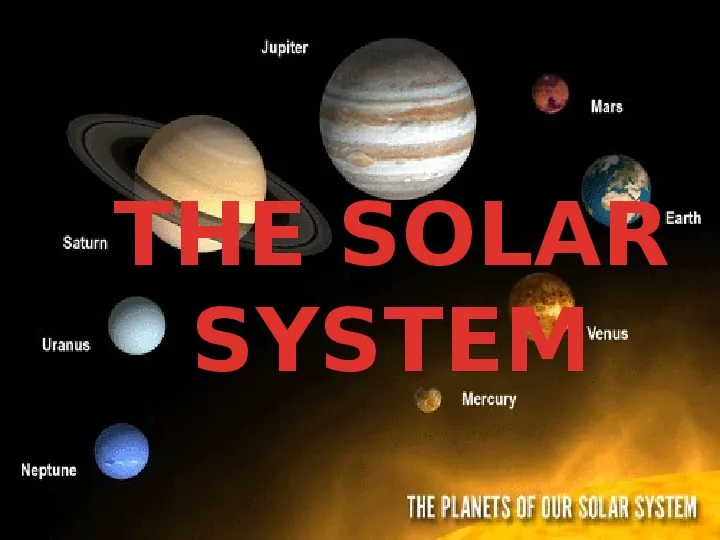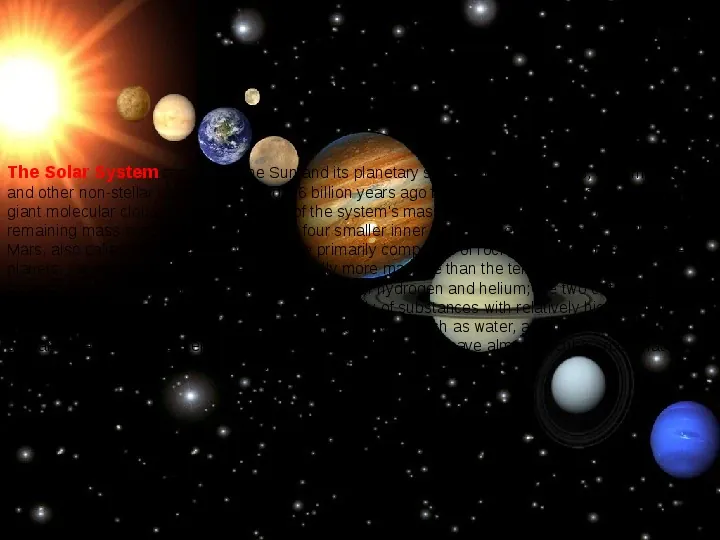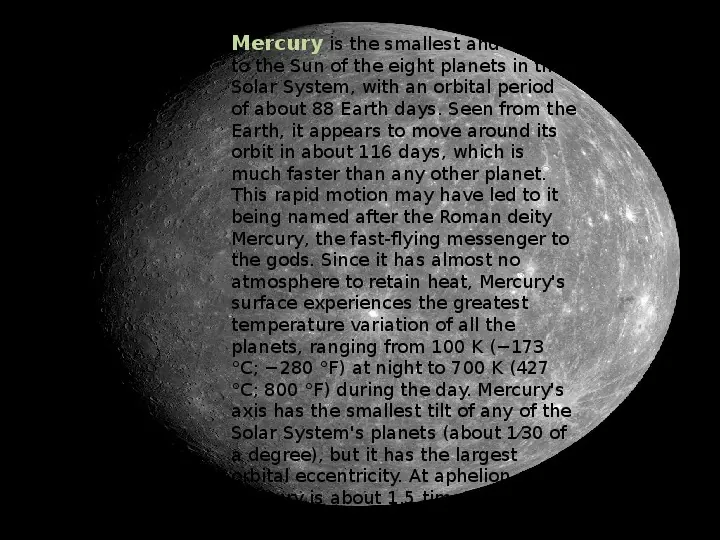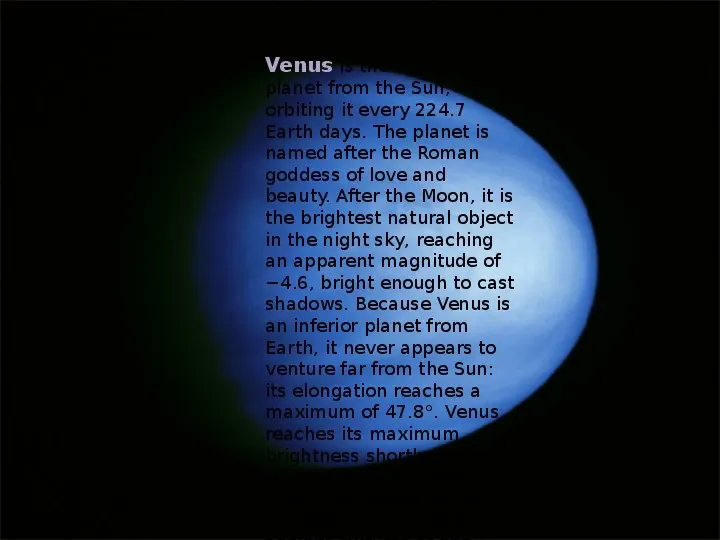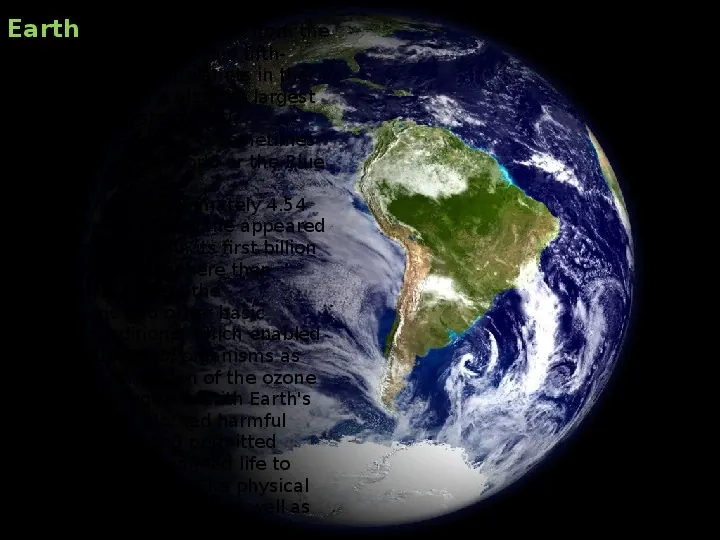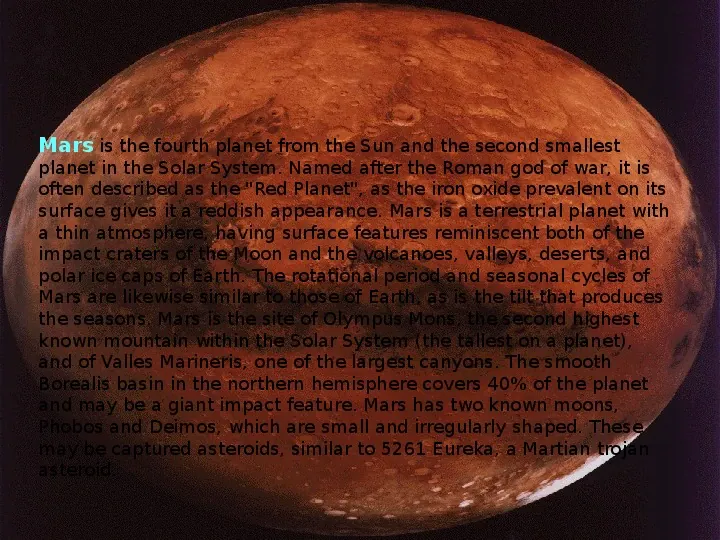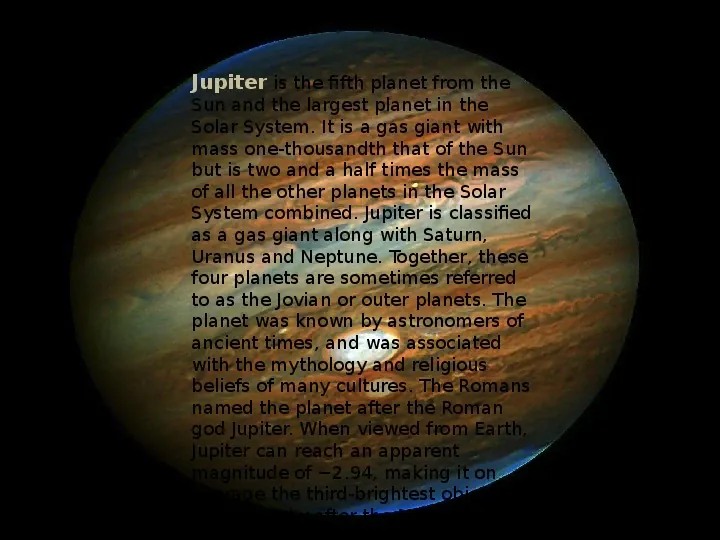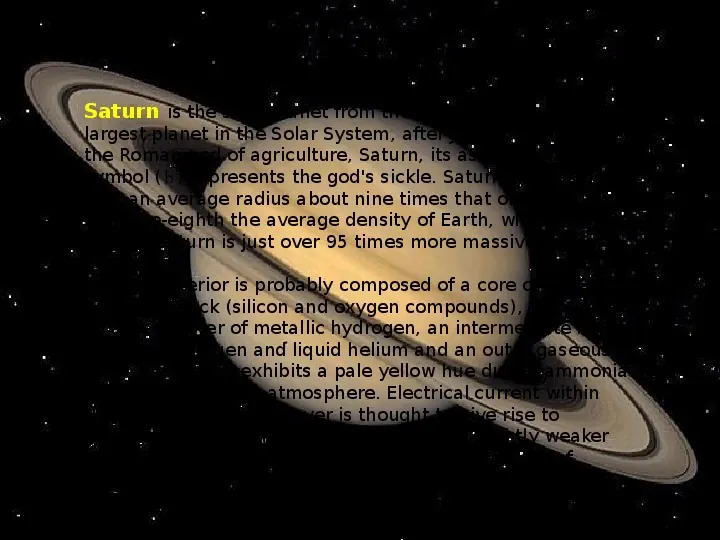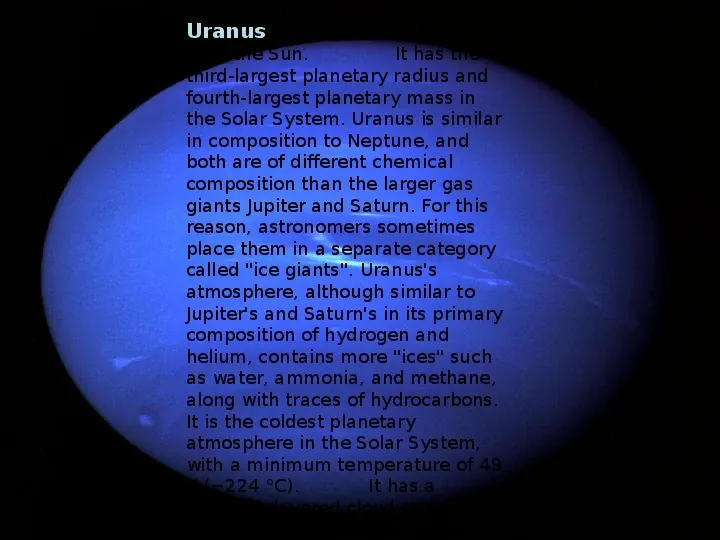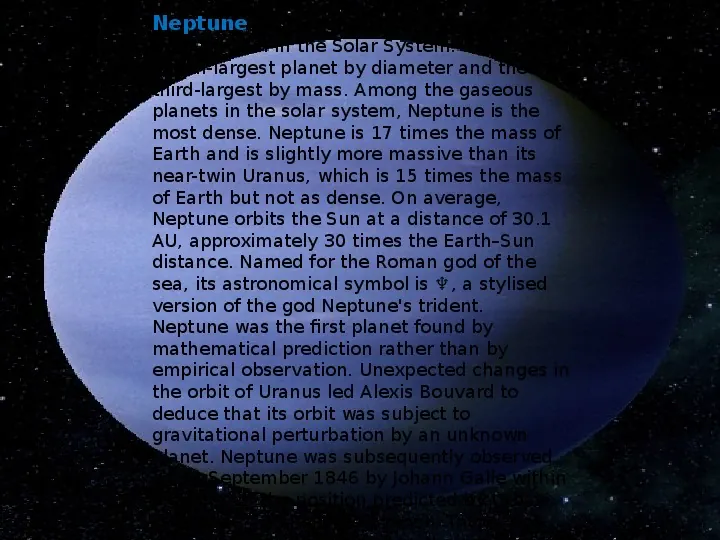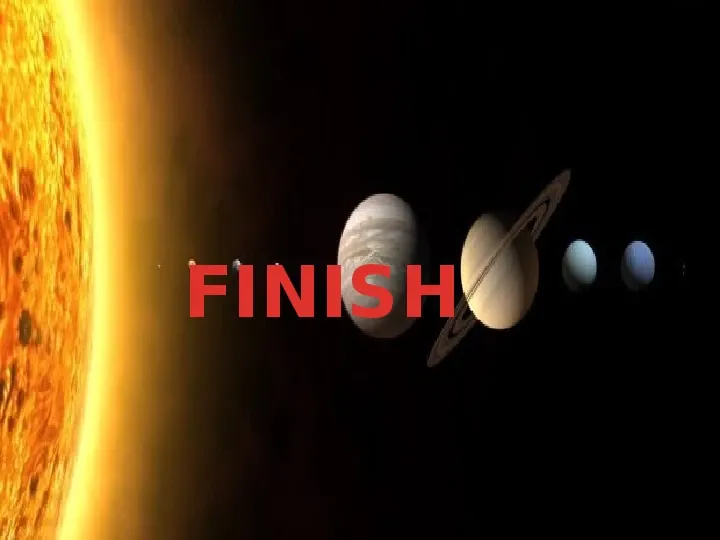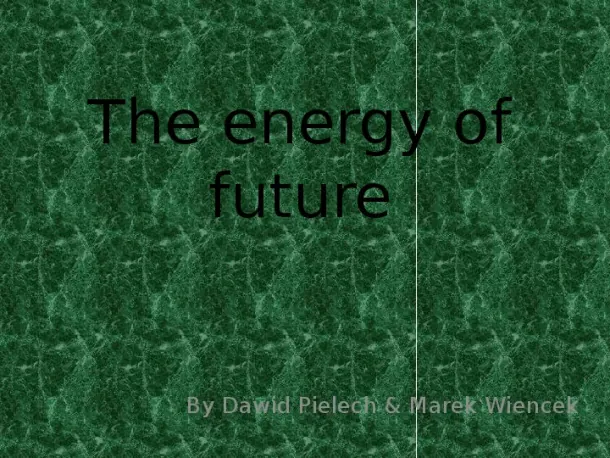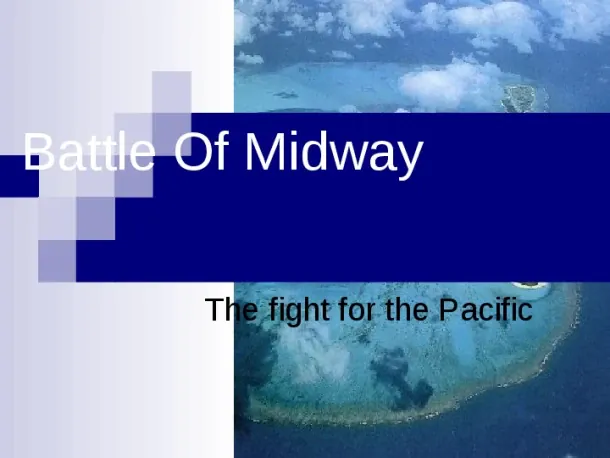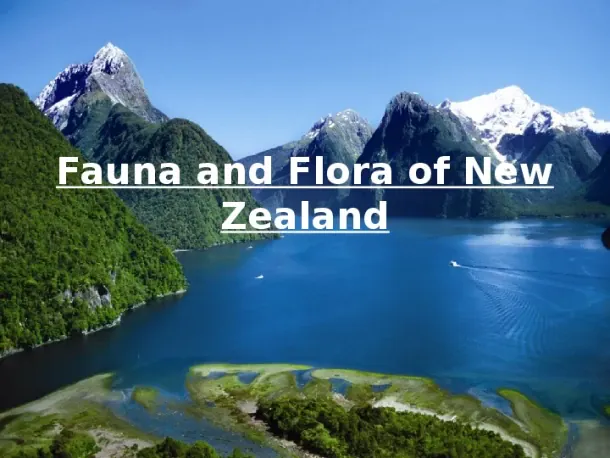Zobacz slidy
Treść prezentacji
Slide 1
THE SOLAR SYSTEM
Slide 2
The Solar System consists of the Sun and its planetary system of eight planets, their moons, and other non-stellar objects. It formed 4.6 billion years ago from the gravitational collapse of a giant molecular cloud. The vast majority of the systems mass is in the Sun, with most of the remaining mass contained in Jupiter. The four smaller inner planets, Mercury, Venus, Earth and Mars, also called the terrestrial planets, are primarily composed of rock and metal. The four outer planets, called the gas giants, are substantially more massive than the terrestrials. The two largest, Jupiter and Saturn, are composed mainly of hydrogen and helium; the two outermost planets, Uranus and Neptune, are composed largely of substances with relatively high melting points (compared with hydrogen and helium), called ices, such as water, ammonia and methane, and are often referred to separately as ice giants. All planets have almost circular orbits that lie within a nearly flat disc called the ecliptic plane.
Slide 3
The Sun is the star at the center of the Solar System. It is almost perfectly spherical and consists of hot plasma interwoven with magnetic fields. It has a diameter of about 1,392,684 km, about 109 times that of Earth, and its mass (about 21030 kilograms, 330,000 times that of Earth) accounts for about 99.86 of the total mass of the Solar System. Chemically, about three quarters of the Suns mass consists of hydrogen, while the rest is mostly helium. The remainder (1.69, which nonetheless equals 5,628 times the mass of Earth) consists of heavier elements, including oxygen, carbon, neon and iron, among others. The Sun formed about 4.6 billion years ago from the gravitational collapse of a region within a large molecular cloud. Most of the matter gathered in the center, while the rest flattened into an orbiting disk that would become the Solar System. The central mass became increasingly hot and dense, eventually initiating thermonuclear fusion in its core. It is thought that almost all other stars form by this process. The Suns stellar classification, based on spectral class, is a G-type main-sequence star (G2V), and is informally designated as a yellow dwarf, because its visible radiation is most intense in the yellow-green portion of the spectrum and although its color is white, from the surface of the Earth it may appear yellow because of atmospheric scattering of blue light. In the spectral class label, G2 indicates its surface temperature of
Slide 4
Mercury is the smallest and closest to the Sun of the eight planets in the Solar System, with an orbital period of about 88 Earth days. Seen from the Earth, it appears to move around its orbit in about 116 days, which is much faster than any other planet. This rapid motion may have led to it being named after the Roman deity Mercury, the fast-flying messenger to the gods. Since it has almost no atmosphere to retain heat, Mercurys surface experiences the greatest temperature variation of all the planets, ranging from 100 K (173 C; 280 F) at night to 700 K (427 C; 800 F) during the day. Mercurys axis has the smallest tilt of any of the Solar Systems planets (about 130 of a degree), but it has the largest orbital eccentricity. At aphelion, Mercury is about 1.5 times as far from the Sun as it is at perihelion.
Slide 5
Venus is the second planet from the Sun, orbiting it every 224.7 Earth days. The planet is named after the Roman goddess of love and beauty. After the Moon, it is the brightest natural object in the night sky, reaching an apparent magnitude of 4.6, bright enough to cast shadows. Because Venus is an inferior planet from Earth, it never appears to venture far from the Sun: its elongation reaches a maximum of 47.8. Venus reaches its maximum brightness shortly before sunrise or shortly after sunset, for which reason it has been referred to by
Slide 6
Earth is the third planet from the Sun, and the densest and fifthlargest of the eight planets in the Solar System. It is also the largest of the Solar Systems four terrestrial planets. It is sometimes referred to as the world or the Blue Planet. Earth formed approximately 4.54 billion years ago, and life appeared on its surface within its first billion years. Earths biosphere then significantly altered the atmospheric and other basic physical conditions, which enabled the proliferation of organisms as well as the formation of the ozone layer, which together with Earths magnetic field blocked harmful solar radiation, and permitted formerly ocean-confined life to move safely to land. The physical properties of the Earth, as well as its geological history and orbit,
Slide 7
Mars is the fourth planet from the Sun and the second smallest planet in the Solar System. Named after the Roman god of war, it is often described as the Red Planet, as the iron oxide prevalent on its surface gives it a reddish appearance. Mars is a terrestrial planet with a thin atmosphere, having surface features reminiscent both of the impact craters of the Moon and the volcanoes, valleys, deserts, and polar ice caps of Earth. The rotational period and seasonal cycles of Mars are likewise similar to those of Earth, as is the tilt that produces the seasons. Mars is the site of Olympus Mons, the second highest known mountain within the Solar System (the tallest on a planet), and of Valles Marineris, one of the largest canyons. The smooth Borealis basin in the northern hemisphere covers 40 of the planet and may be a giant impact feature. Mars has two known moons, Phobos and Deimos, which are small and irregularly shaped. These may be captured asteroids, similar to 5261 Eureka, a Martian trojan asteroid.
Slide 8
Jupiter is the fifth planet from the Sun and the largest planet in the Solar System. It is a gas giant with mass one-thousandth that of the Sun but is two and a half times the mass of all the other planets in the Solar System combined. Jupiter is classified as a gas giant along with Saturn, Uranus and Neptune. Together, these four planets are sometimes referred to as the Jovian or outer planets. The planet was known by astronomers of ancient times, and was associated with the mythology and religious beliefs of many cultures. The Romans named the planet after the Roman god Jupiter. When viewed from Earth, Jupiter can reach an apparent magnitude of 2.94, making it on average the third-brightest object in the night sky after the Moon and
Slide 9
Saturn is the sixth planet from the Sun and the second largest planet in the Solar System, after Jupiter. Named after the Roman god of agriculture, Saturn, its astronomical symbol () represents the gods sickle. Saturn is a gas giant with an average radius about nine times that of Earth. While only one-eighth the average density of Earth, with its larger volume Saturn is just over 95 times more massive than Earth. Saturns interior is probably composed of a core of iron, nickel and rock (silicon and oxygen compounds), surrounded by a deep layer of metallic hydrogen, an intermediate layer of liquid hydrogen and liquid helium and an outer gaseous layer. The planet exhibits a pale yellow hue due to ammonia crystals in its upper atmosphere. Electrical current within the metallic hydrogen layer is thought to give rise to Saturns planetary magnetic field, which is slightly weaker than Earths and around one-twentieth the strength of Jupiters. The outer atmosphere is generally bland and lacking in contrast, although long-lived features can appear. Wind speeds on Saturn can reach 1,800 kmh (1,100 mph),
Slide 10
Uranus is the seventh planet from the Sun. It has the third-largest planetary radius and fourth-largest planetary mass in the Solar System. Uranus is similar in composition to Neptune, and both are of different chemical composition than the larger gas giants Jupiter and Saturn. For this reason, astronomers sometimes place them in a separate category called ice giants. Uranuss atmosphere, although similar to Jupiters and Saturns in its primary composition of hydrogen and helium, contains more ices such as water, ammonia, and methane, along with traces of hydrocarbons. It is the coldest planetary atmosphere in the Solar System, with a minimum temperature of 49 K (224 C). It has a complex, layered cloud structure, with water thought to make up the
Slide 11
Neptune is the eighth and farthest planet from the Sun in the Solar System. It is the fourth-largest planet by diameter and the third-largest by mass. Among the gaseous planets in the solar system, Neptune is the most dense. Neptune is 17 times the mass of Earth and is slightly more massive than its near-twin Uranus, which is 15 times the mass of Earth but not as dense. On average, Neptune orbits the Sun at a distance of 30.1 AU, approximately 30 times the EarthSun distance. Named for the Roman god of the sea, its astronomical symbol is , a stylised version of the god Neptunes trident. Neptune was the first planet found by mathematical prediction rather than by empirical observation. Unexpected changes in the orbit of Uranus led Alexis Bouvard to deduce that its orbit was subject to gravitational perturbation by an unknown planet. Neptune was subsequently observed on 23 September 1846 by Johann Galle within a degree of the position predicted by Urbain Le Verrier, and its largest moon, Triton, was
Slide 12
FINISH
Dane:
- Liczba slajdów: 12
- Rozmiar: 1.89 MB
- Ilość pobrań: 1942
- Ilość wyświetleń: 16406
